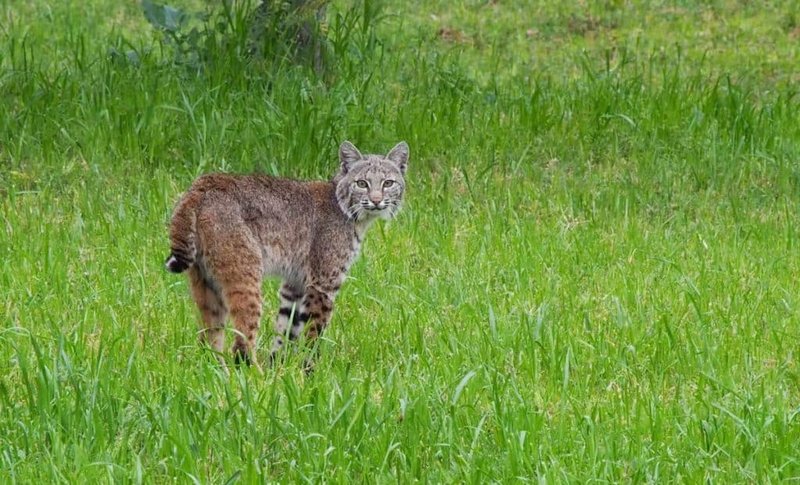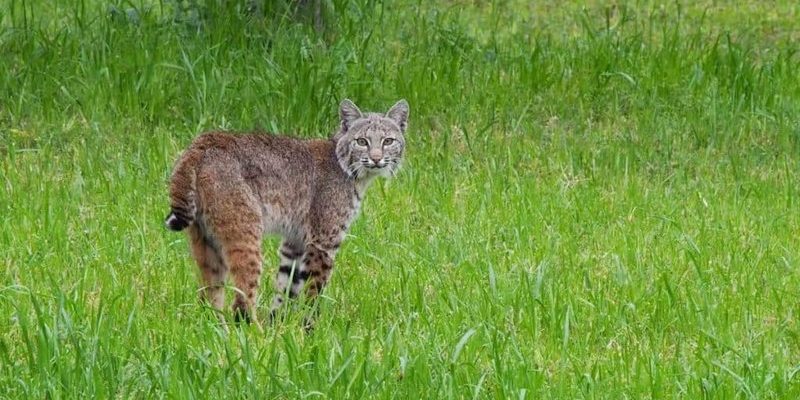
When it comes to identifying these animals, it can feel a bit like playing a game of “spot the difference.” Each species has its own unique traits, habitats, and quirks that set them apart from the bobcat. In this guide, we’ll go through ten animals that might resemble our furry friend, the bobcat, and help you differentiate between them.
1. Lynx
If you thought the bobcat was cool, wait until you hear about the lynx. These cats, which belong to the same family as the bobcat, are often larger and have long legs and tufted ears that make them look fluffy. The lynx’s fur is typically spotted or streaked, similar to the bobcat, but they also have a more pronounced facial ruff that contributes to their distinct look.
You might be wondering, how can I tell a bobcat from a lynx? One quick way is to look at their size. Lynx are generally heavier and can weigh up to 40 pounds, while bobcats are usually smaller, around 15-30 pounds. Additionally, if you see a cat with exceptionally long legs, that’s likely a lynx striding through the underbrush.
2. Canadian Lynx
Now, the Canadian lynx is a specific type of lynx found mostly in North America. Similar to its cousin, the Canadian lynx tends to have a thick, soft coat and those adorable tufts of fur on its ears. However, they are typically found in colder regions, where they’ve adapted to snowy environments.
To distinguish a Canadian lynx from a bobcat, pay attention to the tail. The Canadian lynx has a black-tipped tail, which is much longer than that of a bobcat. And if you’re lucky enough to catch a glimpse of their paws, you’ll notice they are quite large, adapted for walking on snow. It’s like comparing a snowshoe to a regular shoe!
3. Ocelot
Next up is the ocelot, a small wild cat that’s more often found in the jungles and grasslands of Central and South America. While ocelots are about the same size as bobcats, they have a much more pronounced pattern of spots and stripes. Their fur is sleek and has a distinct rosette pattern, almost like a work of art.
So, how can you tell an ocelot apart from a bobcat? Besides the coat markings, check out their eyes. Ocelots have larger, more rounded eyes that give them a more expressive look compared to the more almond-shaped bobcat eyes. If you catch a glimpse of a cat lounging on a tree branch with a striking coat, it’s likely to be an ocelot.
4. Serval
The serval is another cat that can be tricky to mix up with a bobcat. This African feline is known for its long legs and large ears, which give it a stilted appearance. Servals are mostly tan with dark spots, and they have a more slender build than bobcats.
If you see a serval, you’ll probably notice it leaps and bounds in a graceful manner, often when jumping to catch birds or small mammals. One of the key differences, though, is the serval’s huge ears. They are designed to help detect the faintest sounds, which means they almost look comically oversized compared to their head. If you spot a cat looking like it’s ready to jump ten feet into the air, that’s a serval!
5. Caracal
Next on our list is the caracal, a cat that’s as striking as it is elusive. You may know the caracal by its distinctive tufted ears, much like the bobcat. However, the caracal has a more robust body and a shorter face that almost gives it a lion-like appearance.
To spot the difference, notice the color of their fur. Caracals usually have a rich reddish-brown coat and are slightly larger than bobcats. They also have a more muscular build, making them formidable hunters. If you see a cat bolting through the grass with a swift, powerful stride, that could well be a caracal on the move.
6. Jagurundi
The jaguarundi is another player in the family resemblance game. This small cat has a more elongated body and a sleek, low profile compared to the bobcat. Unlike most wild cats, jaguarundis come in solid colors, typically a grayish-brown or reddish hue, with very subtle markings.
The key to identifying a jaguarundi is, of course, its shape and size. They tend to be smaller and have a more weasel-like appearance. If you see a cat that resembles a miniature puma, you’re likely looking at a jaguarundi, especially if it’s moving quickly through the underbrush.
7. Domestic Cat
Believe it or not, domestic cats can sometimes bear a resemblance to bobcats, especially if they have similar coloring or patterns. Many domestic cats have those adorable tufted ears and can be spotted roaming around suburban areas.
To tell a domestic cat apart from a bobcat, you’ll want to look closely at their size. Domestic cats usually weigh much less than bobcats, and their body structure is typically not as robust. If you see a cat lounging on your doorstep that looks like it’s trying to channel its wild side, it might just be a fluffy housecat dreaming of being a bobcat.
8. Wildcat
The wildcat is a more distant relative of the bobcat and is often recognized by its greyish-brown coat adorned with darker stripes. This cat can be found in various habitats across Europe, Africa, and parts of Asia, and while they share a common ancestor, they have some distinct differences.
One of the tell-tale signs of a wildcat is their bushy tail, which contrasts with the bobcat’s stubby one. Additionally, wildcats have a more slender build and tend to be a bit smaller than bobcats. Spotting a wildcat may give you a sense of being transported back in time, as they resemble the wild ancestors of modern domestic cats.
9. Geoffroy’s Cat
This adorable little feline is smaller than a bobcat and sports a similar spotted coat. Found mostly in South America, Geoffroy’s cat is often characterized by its stocky build and short legs.
Identifying a Geoffroy’s cat can be done easily with a close look at its size—these little guys typically weigh around 6-10 pounds, considerably lighter than a bobcat. They also have a more rounded face and a slightly shorter tail. If you ever catch a glimpse of a tiny cat walking confidently through tall grass, it might just be a Geoffroy’s cat on a mini adventure.
10. European Lynx
Last but not least is the European lynx, a larger counterpart to both the bobcat and the Canadian lynx. This cat has striking features, including long tufts on its ears and a thick fur coat that can appear spotted or streaked.
When comparing the European lynx to a bobcat, size is a big giveaway. The European lynx can weigh between 50 to 70 pounds, making it one of the larger felines in the lynx family. If you see a majestic-looking cat with prominently tufty ears and a long body, that’s likely the European lynx strutting its stuff.
It’s fascinating how many cats share similarities with the bobcat, yet each has its own unique attributes. Remember, observing the subtle differences can turn you from a curious observer into a knowledgeable nature enthusiast. Each of these animals tells a story of evolution and adaptation, reminding us of the incredible diversity in our world.

